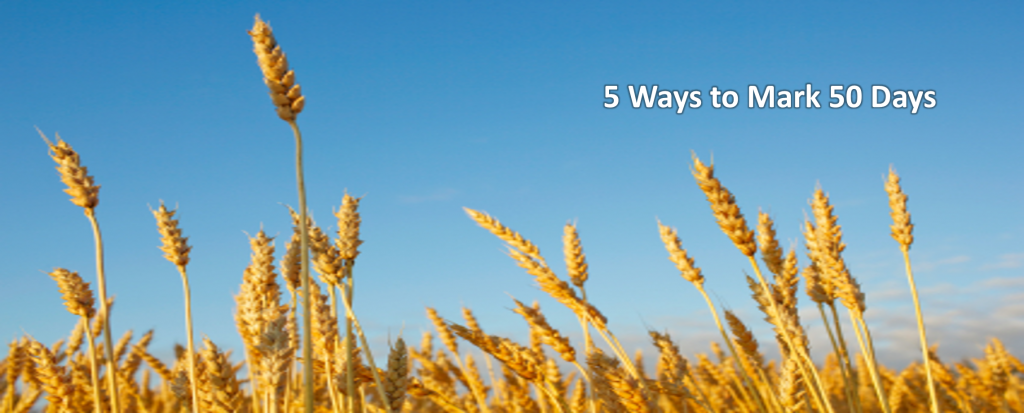The Easter season gives us a unique opportunity to use the calendar as a tool to jump start our spiritual lives. We have the 40 days of Lent before Easter. We have the six-day countdown between Jesus’ Triumphal Entry on Sunday and His crucifixion on Good Friday. We even have a more hourly record during the crucifixion. And of course, we have the three days between Jesus’ death and resurrection.
Each of these segments gives us an element of our walk with God to reflect upon—the sacrifice of Lent, the suffering during trial and crucifixion, the hope of resurrection.
But the reflecting doesn’t stop there.
In fact, one of the most poignant calendar marks comes after Jesus resurrection, the 50 days between Passover and the Day of Pentecost, two Jewish feasts that took on extraordinary new meaning after the events of Jesus’ crucifixion and resurrection. It was at the celebration of Pentecost, a Jewish feast celebrating the harvest, that the Holy Spirit ushered in the age of the church.
The moments below are connected to events or passages surrounding the 50 days leading up to Pentecost and Pentecost itself. Use one, or all five, of these moments either personally or in your ministry to utilize the 50-day stretch of 2015 as a catalyst for a spiritual surge in your relationship with God.
1. Throw an Acts 2-4-2 Party
The verses in Acts 2:42-47 record some of the purest activities of church life, activities of new believers shortly after the Holy Spirit turned the church, and the world, upside down on that historic Day of Pentecost. Dedicate a Bible study or youth event to doing the activities noted in Acts 2:42-47. Be creative on how each activity can be represented in your youth ministry.
2. Celebrate the giving of The Law (Decalogue)
Several celebrations are actually ascribed to Pentecost, i.e., the Feast of Weeks, the Feast of Harvest and the Feast of Firstfruits. Jewish literature connects one more commemoration: the giving of the Law on Mt. Sinai in that the Law was given on the fiftieth day after the exodus from Egypt. So, why not have a similar celebration? Lead your teens in the celebration of their “first Bible.” Dedicate part of a youth gathering or devotional time to share about your first Bible. Display it if you have it. Describe the circumstances surrounding how you received it. Invite students to share, in the same manner, about their first Bible.
3. Identify your concentric circles of Jerusalem, Judea, ends of the earth
Just before His ascension to the Father, Jesus made a bold promise to His disciples, that they “will receive power when the Holy Spirit has come upon you, and you will be my witnesses in Jerusalem and in all Judea and Samaria, and to the end of the earth” (Acts 1:8). Ponder those concentric circles that Jesus offered: Jerusalem (local), Judea/Samaria (regional), and end of the earth (worldwide). Apply these same circles to your walks of life. List parallel concentric circles connected with the suggested walks of life below. The first is done as an example
School (Jerusalem: close friends; Judea/Samaria: people in my class; ends of the earth: entire school)
Work
Family
Community
Consider how, with the power of the Holy Spirit, you can be Jesus’ testimony in those circles.
4. Restoration Party
One of the most poignant scenes that took place in the 50-day stretch between Jesus’ resurrection and the Day of Pentecost was Jesus’ restorative moment with Peter, John 21:15-19. Read that passage in conjunction with one of Peter’s less stellar moments during Jesus’ trial (Matthew 26:69-75; Mark 14:66-72; Luke 22:55-62). Write a devotional thought about what Peter must have been thinking in John 21 as he was talking to Jesus.
5. Earth Shattering Prayer Party
This event occurred after the Day of Pentecost, perhaps Day 50 plus 2, but it was certainly a direct result of the outpouring of God’s Spirit on the Day of Pentecost. In fact, it was a prayer party so raucous that the ground shook. We would be wise to imitate the prayer lives of those early believers. Read Acts 4:23-31 (or all of Acts 4 to get the full context) and create a prayer outline that follows the pattern of the prayer of the believers in this passage. Use this outline as a guide for your personal prayer during this 50-day stretch.
